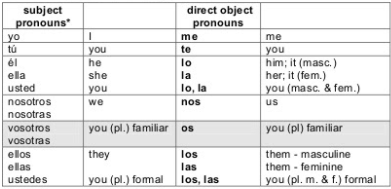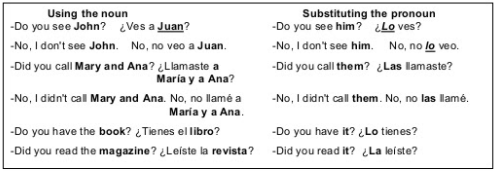What Is Direct Object Pronouns In Spanish?
In English a direct object is the person or thing in a sentence that receives the action of the verb. It answers the question whom? or what?
In The Example Below “The Lamp” Is The Direct Object Pronoun.
- Claudia dusts the lamp
- What did Claudia dust?
In The Example Below “Teresa” Is The Direct Object Pronoun.
- Marcos invites Teresa
- Whom does Marcos invite?
In This Example Below “The Beds” Is The Direct Object Pronouns.
- Pablo makes the beds.
- What does Pablo make.
Direct object pronouns can be used instead of nouns. Four English forms of these pronouns are: him, her, it, and them.
Direct Object Pronouns Are Used To Replace Direct Objects In Spanish As We See In English.
Four Spanish Direct Object Pronouns Are:
- Lo.
- La.
- Los.
- Las.
The Use Of Direct Object Pronouns Depends On The Gender And Number Of The Direct Object It Replaces.
Masucline
- Lo = It & Him
- Los = Them
- La = It & Her
- Las = Them
Must Read : What Is Reflexive Pronouns?
In English, Nouns Are Replaced By Pronouns.
For Example :-
- Do you see John? – No, I don’t see John.
-
Did you call Mary and Ana? – No, I didn’t call Mary and Ana.
With Pronouns We Can Easily Simplify This.
- Do you see John? – Do you see him?
- No, I don’t see John – No, I don’t see him
- Did you call Mary and Ana? – Did you call them?
- No, I didn’t call Mary and Ana. – No, I didn’t call them.
In Spanish, nouns are also replaced by pronouns. We have already learned the subject pronouns. There are also direct object pronouns. Study the following chart.


Some Examples Using The Noun
- Do you see John? — (Spanish) ¿Ves a Juan?
- No, I don’t see John. — (Spanish) No, no veo a Juan.
- Did you call Mary and Ana? — (Spanish) ¿Llamaste a María y a Ana?
- No, I didn’t call Mary and Ana. No, no llamé a Maria y a Ana.
- Did you read the magazine? ¿Leiste la revista?
- Do you have the book? ¿Tienes el libro?
Some Examples Substituting The Pronouns
- Do you see him? ¿Lo ves?
- No, I don’t see him. No, no lo veo.
- Did you call them? ¿Las llamaste? –
- No, I didn’t call them. No, no las llamé.
- Do you have it? ¿Lo tienes? -Did you read it? ¿La leiste?
- Yo como manzanas. – I eat apples
- Yo las como todo el tiempo. – I eat them all the time.
- Él lee un libro. – He reads a book.
- Él lo lee después del colegio. – He reads it after school.
- Ella puede ver a Sally. – She can see Sally
- Ella la puede ver. -She can see her.
- Ella puede verla. – She can see her.
- Ella puede ver los elefantes. – She can see the elephants
- Ella los puede ver. – She can see them.
- Ella puede verlos. – She can see them.
